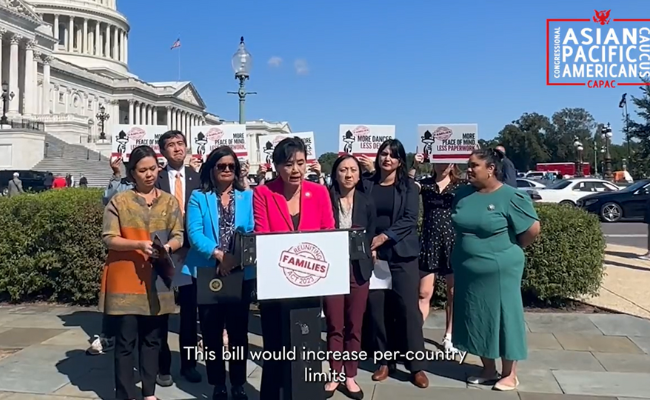Reintroduced ‘Reuniting Families Act’ focuses on Asian immigrant families

Photo screenshot from CAPAC/X
Many Filipinos in the United States aspire to reunite with their loved ones in the Philippines. While some are already living the “American Dream” with families, it can take decades for a US citizen to reunite with even one family member.
To address issues similar to this, the Reuniting Families Act aims to implement various measures to accelerate and enhance the process of family reunification.
On Sept. 19, Congressional Asian Pacific American Caucus (CAPAC) members and Asian immigrant rights activists announced the reintroduction of the Reuniting Families Act and zeroes in on Asian immigrant families.
First introduced by Rep. and CAPAC Chair Judy Chu (CA-28) in February 2018, the act refers to efforts to make it easier for family members, such as spouses, children, and parents, to reunite with families who are US citizens or legal permanent residents.
These reforms may involve changes in visa categories, processing times, and other aspects of the immigration system to prioritize and expedite reunification.
Bureaucratic delays at major play
At a press conference near Capitol Hill on Tuesday, Chu expressed concern that due to bureaucratic delays, three-quarters of the family visas that were supposed to be issued in 2021 have been lost.
In a livestream on X (formerly Twitter), Chu pinpointed the fact that Asians comprised over a million people who are still in immigration backlogs for years.
You may also like: Understanding U.S. Immigration Issues: A Comprehensive Guide for Filipinos
“I’m particularly concerned about how this backlog is affecting families from Asia. Asians make up not only 80 percent of the employment visa backlog but they make up 40 percent of the four million family-based visa backlog,” she said.
“Family-based immigration is an American value and contributes to the economic prosperity and resilience of our nation, but our broken immigration system forces almost four million people with approved green card applications to suffer in bureaucracy for years, if not decades.”
With nearly 4 million people waiting in family immigration backlogs, the Reuniting Families Act could help many of them rejoin their loved ones. This bill also helps ease deep labor shortages that help strengthen the U.S. economy. pic.twitter.com/F1gFjrWwmc
— CAPAC (@CAPAC) September 19, 2023
This is where the bill fills comes in as it seeks to eliminate visa backlogs by carrying over unused visas, exempting specific family members like children and spouses from numerical restrictions, capping green card processing at 10 years, and increasing per-country visa limits to 15 percent, which will “more than double the number of family-preference visas available.”
Prior to this year, the act was also reintroduced in 2019. Proponents of the act are optimistic that it can contribute to the improvement of the immigration system.

